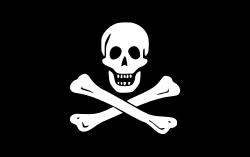| ☠🕱 | |
|---|---|
Skull and crossbones | |
| In Unicode | U+2620☠SKULL AND CROSSBONES U+1F571🕱BLACK SKULL AND CROSSBONES |
| Related | |
| See also | U+2623☣ BIOHAZARD SIGN U+2622☢ RADIOACTIVE SIGN |
A skull and crossbones is a symbol consisting of a human skull and two long bones crossed together under or behind the skull. [1] The design originated in the Late Middle Ages as a symbol of death and especially as a memento mori on tombstones. Actual skulls and bones were long used to mark the entrances to Spanish cemeteries (campo santo).
Contents
In modern contexts, it is generally used as a hazard symbol, usually in regard to poisonous substances, such as deadly chemicals. [1]
It is also associated with piracy and software piracy, due to its historical use in some Jolly Roger flags.











